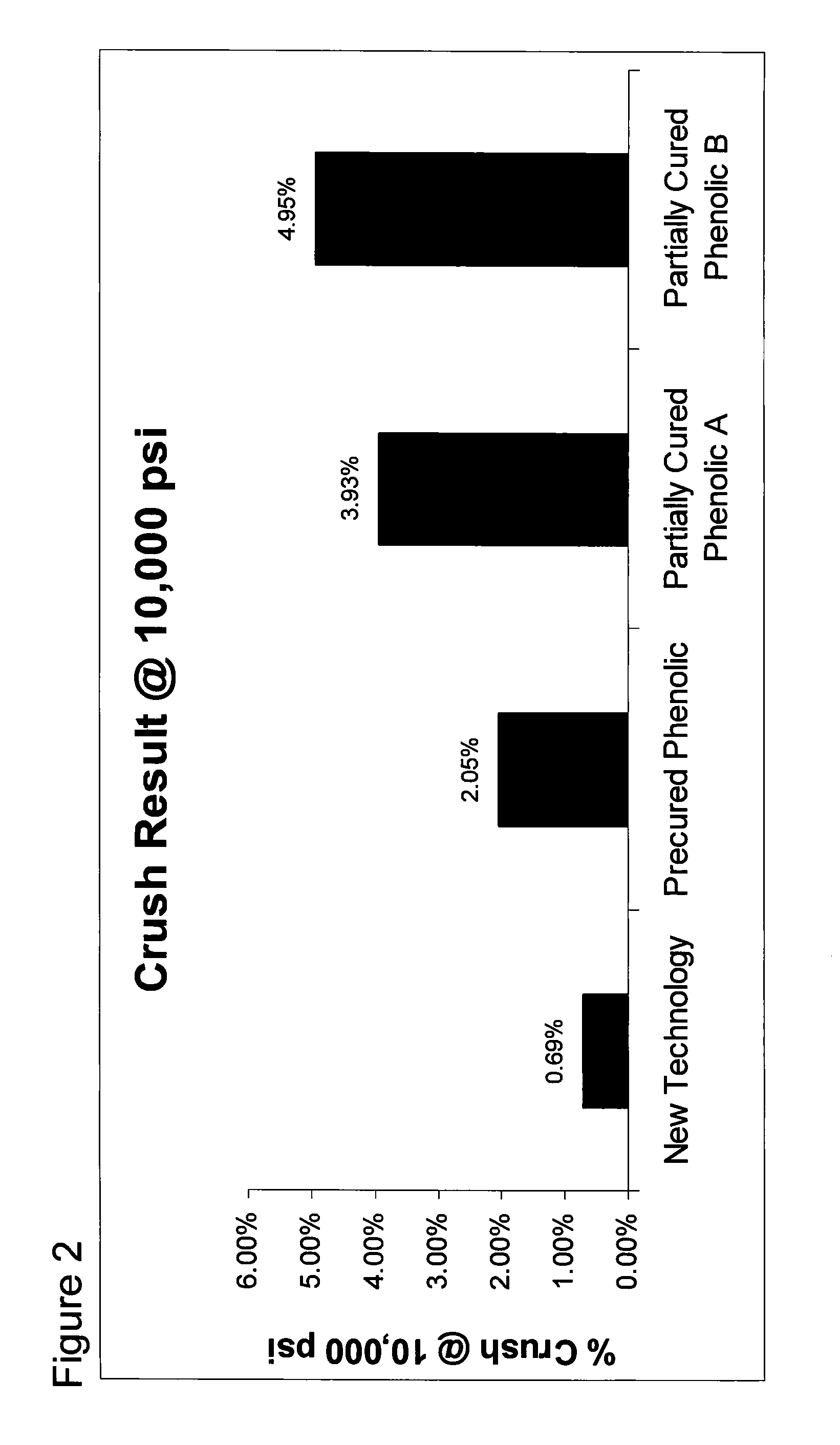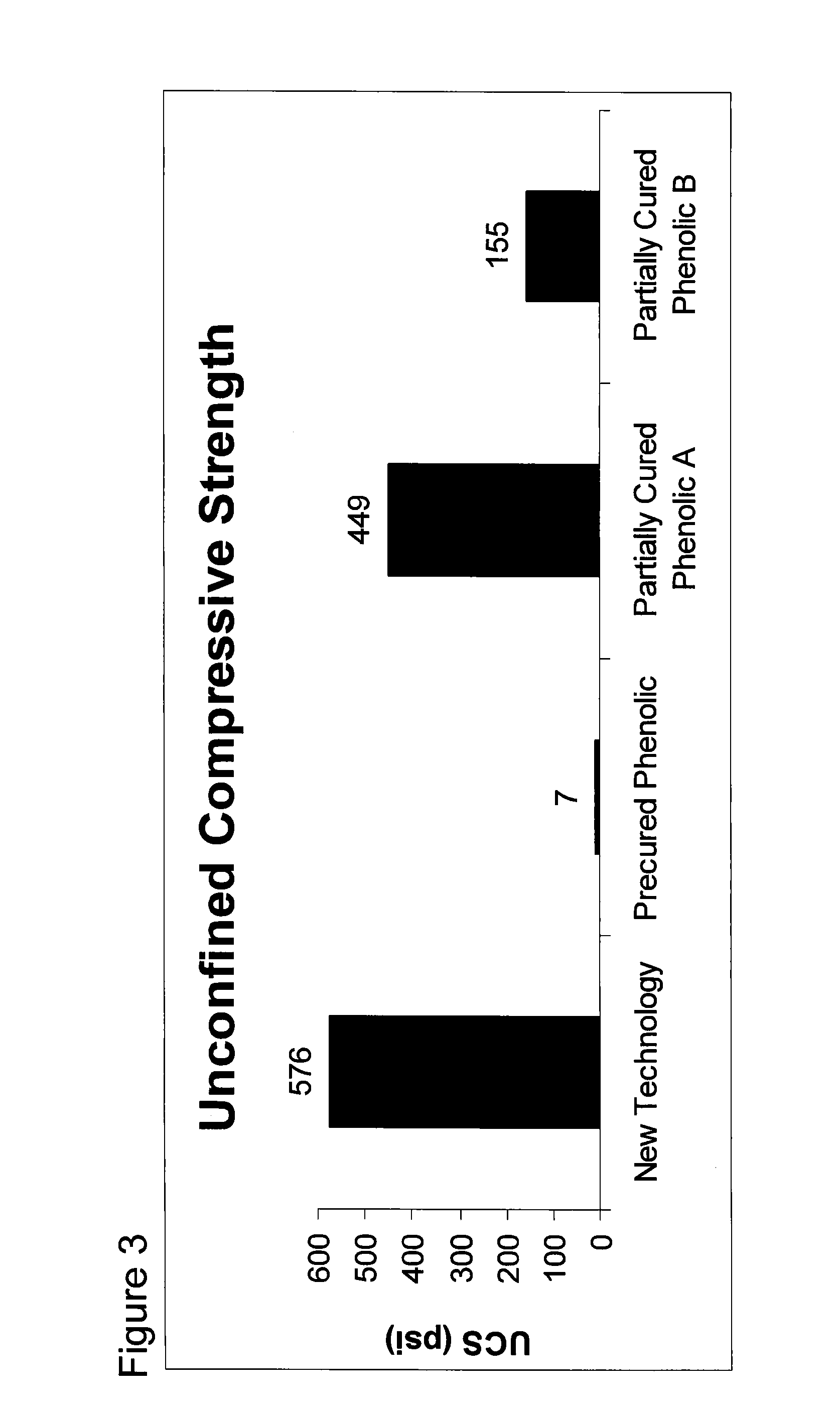Coated and cured proppants
a technology of proppants and coatings, applied in the direction of coatings, fluid removal, borehole/well accessories, etc., can solve the problems of inability to cure, damage or block the tubular goods used, and undesirable flow back of proppants, etc., to achieve low dust generation, good crush resistance, and high production rate
- Summary
- Abstract
- Description
- Claims
- Application Information
AI Technical Summary
Benefits of technology
Problems solved by technology
Method used
Image
Examples
example 1
[0143]Ten pounds of Minnesota 40 / 70 fracturing sand is heated to 200° F. in a laboratory mixer at which point the following components are added in the sequence and timing as given below in Tables 1 and 2. The weight ratio of the poly-MDI to phenolic polyol in this example is 75 / 25.
TABLE 1WEIGHT(grams)COMPONENT4540Minnesota sand4.5silane coupling agent2.350% red iron oxide in castor oil6.91,3,5-tris(3-(dimethylamino)propyl)-hexahydro-s-triazine(JEFFCAT TR90)34.2Phenolic Polyol comprising 48% phenolic resin, 28%cashew nut oil, 24% castor oil102.2Poly-MDI (32% NCO content)2.5Wetting agent
TABLE 2TIME(minutes:seconds)ADDITION / COMMENT0:00Sand is at 200° F.0:004.5 gms silane coupling agent is added over 30 secs0:00JEFFCAT TR90 is added over 20 secs0:00Blend of red iron oxide and Phenolic Polyol isadded over 60 seconds0:10Poly-MDI is added over 60 seconds2:00Product is free flowing3:30Wetting agent is added over 5 seconds4:00Product is discharged at 180° F.
[0144]In this and the other examp...
example 2
[0146]Ten pounds of Genoa 40 / 70 fracturing sand is heated to 204° F. in a laboratory mixer at which point the following components are added in the sequence and timing as given below in Tables 3 and 4. The weight ratio of the poly MDI to phenolic polyol in this example is 75 / 25.
TABLE 3WEIGHT(grams)COMPONENT4540Genoa sand4.5A1100 silane coupling agent2.350% red iron oxide in castor oil6.9JEFFCAT TR9018.2Phenolic Polyol comprised of 48% phenolic resin, 28%cashew nut oil, 24% castor oil54.5Poly-MDI (32% NCO content)2.3Wetting agent
TABLE 4TIME(minutes:seconds)ADDITION / COMMENT0:00Sand is at 204° F.0:004.5 gms A1100 is added over 10 secs0:00JEFFCAT TR90 is added over 10 secs0:00blend of red iron oxide and Phenolic Polyol isadded over 30 seconds0:10polyMDI is added over 30 seconds2:00Product is free-flowing3:30Wetting agent is added over 5 seconds4:00Product is discharged at 182° F.
[0147]The resin coated sand from the example above tested at 1.48% LOI from the mixer. When subjected to a th...
example 3
[0148]Ten pounds of Minnesota fracturing sand is heated to 200° F. in a laboratory mixer at which point the following components are added in the sequence and timing as given below in Tables 5 and 6. The weight ratio of the poly MDI to phenolic polyol in this example is 92 / 8.
TABLE 5WEIGHT(grams)COMPONENTS:4540Minnesota sand4.5A1100 silane coupling agent2.350% red iron oxide in castor oil6.9JEFFCAT TR 9012Phenolic Polyol comprised of 48% phenolic resin, 28%cashew nut oil, 24% castor oil135Poly-MDI (32% NCO content)2.5Wetting agent
TABLE 6TIME(minutes:seconds)ADDITION / COMMENT0:00Sand is at 202° F.0:00A1100 is added over 20 secs0:00JEFFCAT TR90 is added over 20 secs0:00Blend of red iron oxide and Phenolic Polyol isadded over 60 seconds0:10Poly-MDI is added over 60 seconds2:00Product is free flowing3:30Wetting agent is added over 5 seconds4:00Product is discharged at 170° F.
[0149]The resin coated sand from example 3 tested at 2.80% coating loss from the mixer. When subjected to a three d...
PUM
| Property | Measurement | Unit |
|---|---|---|
| particle size | aaaaa | aaaaa |
| temperature | aaaaa | aaaaa |
| temperature | aaaaa | aaaaa |
Abstract
Description
Claims
Application Information
 Login to View More
Login to View More - R&D
- Intellectual Property
- Life Sciences
- Materials
- Tech Scout
- Unparalleled Data Quality
- Higher Quality Content
- 60% Fewer Hallucinations
Browse by: Latest US Patents, China's latest patents, Technical Efficacy Thesaurus, Application Domain, Technology Topic, Popular Technical Reports.
© 2025 PatSnap. All rights reserved.Legal|Privacy policy|Modern Slavery Act Transparency Statement|Sitemap|About US| Contact US: help@patsnap.com



